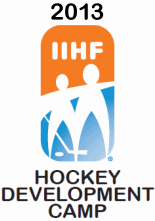VIERUMÄKI – When walking along the dressing rooms at the ice rink in Vierumäki, players often assemble behind a wall. That’s where all statistics are presented as part of the Result Manager Program.
And behind the wall is the room where the result managers assemble to improve their program. It’s a room with several tables filled with laptops and cables while papers cover the walls with handwritten notes about statistical definitions, topics and assignments.
The program is usually not part of the Hockey Development Camp. Last time it was run was five years ago. Not any class of players can enjoy this kind of detailed statistical coverage at the camp like this year on the stats board or online but the main purposes are others.
“It was time to do it since we have had many new people over the years and many didn’t know each other. We have result managers from countries that are further away like Australia, Japan, South Africa or Turkey who can profit from seeing how it’s run at a larger scale,” said IIHF Sport Data Manager Andy Ecker.
The crew runs statistics on a large scale at the camp, with a full setup like at the 2013 IIHF Ice Hockey World Championship in Stockholm and Helsinki. That means including resource-intensive figures such as shots, face-offs or time on ice.
“This gives our result managers from all around the world the chance to get to the same level since we run most tournaments with a smaller setup than at our flagship event,” Ecker said.
And same as for coaches and team managers, it’s an educational process where the participants can learn without the pressure of dozens of TV stations, hundreds of journalists and thousands of fans following the game online.
17 participants from 16 countries made it all the way to Vierumäki. In total the network of IIHF Result Managers contains of 24 persons.
It’s a pool of men and women who are sent to the various events around the world and who are responsible for the statistics on-site as representatives of the IIHF Sport Department. They go there and work with local statistics staff from the organizer like operators and spotters, give them the necessary instructions and education and check the technical infrastructure with the host.
The result managers have knowledge both in hockey and in statistics. They are computer-savvy and some of them have professional IT background.
Often they are close to a national ice hockey association or a club and can use their knowledge they gain with the IIHF also within their country.
They don’t work full-time for the IIHF but take time off from work for tournament assignments.
“We rotate the staff here so everybody sees everything and gets a feeling for the different tasks,” Ecker said.
Training and educating is one important purpose to have the result managers here, another is to bring in new ideas and find suggestions to improve the system.
Another important goal is working on statistical regulations.
“It’s a document where we define standards that can be used by our associations, leagues, clubs, coaches, players and fans who are interested in stats,” Ecker said.
Also volunteers working in the stats area in events, whether international or national, shall profit from the document. It’s the goal to compile questions and find the appropriate answers. Stay tuned on IIHF.com if you’re interested in this document that will be released later.
“It’s about how exactly do we define things like shots, time on ice or who is the game-winning goalkeeper if there’s a goalkeeper change,” Ecker said. “We had brainstorming sessions about things like that and try to put everything on paper to clarify such topics.”
One such example is the definition of a shot.
A post shot is neither a shot nor a save for a goalie while it’s a missed shot for the shooter. And a shot that is blocked by the goalie must be intended to qualify as a shot and consequently as a save. That means that for example a loose puck saved by the goalkeeper’s stick doesn’t count as a shot or save at IIHF events.
The IIHF also captures players on ice on power play goals in its game reports to offer this information to the public but these goals don’t count in the +/- stats.
At the same time the group is also working on a more internal guide for the result managers about the work and duties before, during and after the tournaments.
The participants were split in two groups who were trained here and who worked at the documents for a few days each and met altogether during one overlapping day. The second group will travel home on Sunday together with the participants of the other programs run in Vierumäki.
MARTIN MERK |







